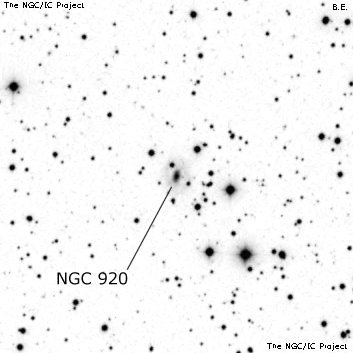NGC/IC Project Restoration Effort
(This is a very very beta version)
NGC920


Basic Information
Location and Magnitude
Right Ascension: 2:28:45.8
Declination: +45:58:16
Constellation: AND
Visual Magnitude: 13.7
Historic Information
Discoverer: Swift L.
Year of discovery: 1885
Discovery aperture: 16.0
Observational
Summary description: eF, eS, R, 1 or 2 eF st nr
Sub-type: S?
Corwin's Notes
=====
NGC 920 = IC 1799. For decades, indeed for more than a century, most of us
have accepted the galaxy that we now call UGC 1920 as NGC 920. It is, after
all, only +16 seconds in RA, and +1.3 arcmin in Dec off Lewis Swift's
position (02 20 10, +45 27 05), not all that far given Swift's usual
statistical errors of 2-3 arcmin. The galaxy itself matches his description
pretty well: "eF, eS, R; 1 or 2 eF * close; e diff." Swift found his object
on 11 September 1885, the same night he found NGC 933 which is nearby to the
east.
We might wonder about the nearby stars; there are three relatively bright ones
forming a fine triangle just 2 1/2 arcmin southwest of the galaxy. We might
have expected Swift to mention that triangle explicitly, but he doesn't. But
that little detail never surfaced as few of us had looked closely at the field
or at Swift's original paper.
Steve Gottlieb did both. His note early in January 2014 to Wolfgang and me
reads in part:
Swift's position for II-20 [the 20th object in his second list of nebulae,
published in AN 2707] is also 70 tsec due west of IC 1799 = UGC 1943, and an
excellent match in declination (given Swift's general accuracy). So,
IC 1799 is only off in RA from Swift's position. His description mentions
"1 or 2 eF* nr", which could apply to either galaxy, but UGC 1920 also has
brighter nearby stars that to me would be mentioned [it was this that
alerted me to the triangle of stars; I believe that these are the ones Steve
mentions]. More importantly, though, IC 1799 is a more prominent galaxy
than UGC 1920. In fact I probably would have missed UGC 1920 (the halo is
very low surface brightness) in my 18-inch if I wasn't looking in the right
place. IC 1799, on the other hand, was immediately noticed in the field,
and has a much higher surface brightness. So, I'm suggesting NGC 920 =
IC 1799 = UGC 1943.
Wolfgang wrote back that his copy of Swift's paper came from Max Wolf's
library in Heidelberg, and has "The '0' (of 20) is struck through and a '1' is
noted to the right of the digit." So, Wolf, too, suspected a 1 minute error
in Swift's RA (02 20 10 for 1885, as published). This leads to a difference
in RA of only -10 seconds in RA and just -7 arcseconds in Dec -- negligible,
in the face of Swift's usual errors.
Steve's only remaining question is why did Swift not call his 20th and 21st
objects in his second list -- NGC 933 is the 21st -- a pair? Specifically, he
often says of galaxies oriented like this "np of 2" and "sf of 2", but does
not in this case. Instead, he says, interestingly, of both galaxies, "Powers
132, 200, and 265". Mention of different magnifications is a very rare
comment for him. The fact that he appends it to the descriptions for both
objects does connect them, at least vicariously.
Given all of this, especially the easier visibility of IC 1799, we have
decided to accept Steve's (and Wolf's!) idea that Swift's object is actually
the same one that Bigourdan came across five years later in January of 1891.
Steve's Notes
=====
NGC 920
17.5" (8/5/97): fairly faint, fairly small, elongated 5:2 SW-NE, broad concentration to a brighter core. A mag 14 star is at the west edge . Viewed after glimpsing UGC 1920 (the galaxy taken to be NGC 920), which is 9.5' W.
UGC 1920 (listed as NGC 920 in all modern sources) appeared extremely faint, moderately large, ~1.5' diameter, very low surface brightness, required averted vision to glimpse. This roundish unconcentrated glow is situated within a group of stars including a mag 11 star 1.6' WSW and mag 13 stars 1' NW and 1' SE. I would not have noticed this object without averted vision and knowing the exact location using a printed finder chart. Located 9.5' W of much brighter NGC 920 = IC 1799 and 15' WNW of NGC 933.
17.5" (11/26/94): fairly faint, fairly small, elongated 5:2 SSW-NNE, 1.0'x0.4', broad concentration to a fairly bright core and occasional stellar nucleus. A mag 14 star is very close west and a mag 12 star (unequal double) is 1.4' NNW. Located in a rich star field 11' WSW of a mag 7 SAO 38067. Brighter of a pair with NGC 933 6.6' ESE.



